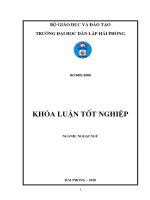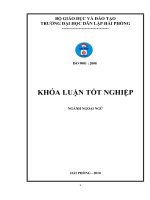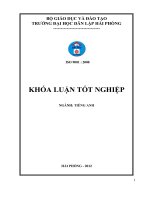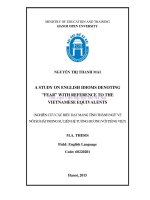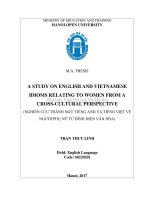A study on business idioms relating to specific business activities
Bạn đang xem bản rút gọn của tài liệu. Xem và tải ngay bản đầy đủ của tài liệu tại đây (431.49 KB, 65 trang )
1
BỘ GIÁO DỤC VÀ ĐÀO TẠO
TRƯỜNG ĐẠI HỌC DÂN LẬP HẢI PHÒNG
ISO 9001 : 2008
KHÓA LUẬN TỐT NGHIỆP
NGÀNH: TIẾNG ANH
HẢI PHÒNG - 2012
2
HAIPHONG PRIVATE UNIVERSITY
FACULTY OF FOREIGN LANGUAGES
ISO 9001 : 2008
GRADUATION PAPER
A STUDY ON BUSINESS IDIOMS RELATING TO
SPECIFIC BUSINESS ACTIVITIES
By:
BUI THI HA
Class:
NA 1201
Supervisor:
DANG THI VAN.MA
HAI PHONG - 2012
3
BỘ GIÁO DỤC VÀ ĐÀO TẠO
TRƯỜNG ĐẠI HỌC DÂN LẬP HẢI PHÒNG
Nhiệm vụ đề tài tốt nghiệp
Sinh viên: Mã số:
Lớp: Ngành:
Tên đề tài:
4
Nhiệm vụ đề tài
1. Nội dung và các yêu cầu cần giải quyết trong nhiệm vụ đề tài tốt nghiệp
( về lý luận, thực tiễn, các số liệu cần tính toán và các bản vẽ).
……………………………………………………………………………
……………………………………………………………………………
……………………………………………………………………………
……………………………………………………………………………
……………………………………………………………………………
……………………………………………………………………………
……………………………………………………………………………
……………………………………………………………………………
2. Các số liệu cần thiết để thiết kế, tính toán.
……………………………………………………………………………
……………………………………………………………………………
……………………………………………………………………………
……………………………………………………………………………
……………………………………………………………………………
……………………………………………………………………………
……………………………………………………………………………
……………………………………………………………………………
……………………………………………………………………………
3. Địa điểm thực tập tốt nghiệp.
……………………………………………………………………………
……………………………………………………………………………
……………………………………………………………………………
5
CÁN BỘ HƯỚNG DẪN ĐỀ TÀI
Người hướng dẫn thứ nhất:
Họ và tên:
Học hàm, học vị:
Cơ quan công tác:
Nội dung hướng dẫn:
Người hướng dẫn thứ hai:
Họ và tên:
Học hàm, học vị:
Cơ quan công tác:
Nội dung hướng dẫn:
Đề tài tốt nghiệp được giao ngày tháng năm 2012
Yêu cầu phải hoàn thành xong trước ngày tháng năm 2012
Đã nhận nhiệm vụ ĐTTN Đã giao nhiệm vụ ĐTTN
Sinh viên Người hướng dẫn
Hải Phòng, ngày tháng năm 2012
HIỆU TRƯỞNG
GS.TS.NGƯT Trần Hữu Nghị
6
PHẦN NHẬN XÉT TÓM TẮT CỦA CÁN BỘ HƯỚNG DẪN
1. Tinh thần thái độ của sinh viên trong quá trình làm đề tài tốt nghiệp:
……………………………………………………………………………
……………………………………………………………………………
……………………………………………………………………………
……………………………………………………………………………
……………………………………………………………………………
……………………………………………………………………………
……………………………………………………………………………
……………………………………………………………………………
2. Đánh giá chất lượng của khóa luận (so với nội dung yêu cầu đã đề ra trong
nhiệm vụ Đ.T. T.N trên các mặt lý luận, thực tiễn, tính toán số liệu…):
……………………………………………………………………………
……………………………………………………………………………
……………………………………………………………………………
……………………………………………………………………………
……………………………………………………………………………
……………………………………………………………………………
……………………………………………………………………………
……………………………………………………………………………
……………………………………………………………………………
3. Cho điểm của cán bộ hướng dẫn (ghi bằng cả số và chữ):
……………………………………………………………………………
……………………………………………………………………………
……………………………………………………………………………
Hải Phòng, ngày … tháng … năm 2012
Cán bộ hướng dẫn
(họ tên và chữ ký)
7
NHẬN XÉT ĐÁNH GIÁ
CỦA NGƯỜI CHẤM PHẢN BIỆN ĐỀ TÀI TỐT NGHIỆP
1. Đánh giá chất lượng đề tài tốt nghiệp về các mặt thu thập và phân tích tài liệu,
số liệu ban đầu, giá trị lí luận và thực tiễn của đề tài.
2. Cho điểm của người chấm phản biện :
(Điểm ghi bằng số và chữ)
Ngày tháng năm 2012
Người chấm phản biện
8
Acknowledgements
I am extremely grateful to all of the people for helping me to finish my
graduation paper.
Firstly of all, I wish to express my sincere thanks and deepest gratitude to
my supervisor- Ms. Dang Thi Van for her whole- hearted guidance and
valuable suggestion during the process of doing this research.
Additionally, I am also grateful to all of the teachers of Faculty Of Foreign
Languages of HaiPhong Private University for their enthusiastic assistance
during the time I studied at the university.
I wish to forward my special thanks to my parents and my friends for
whatever they support and encourage me both mentally and physically in
this time.
I am fully aware that shortcomings and mistakes are inevitable in my
research. Any comment and suggestion would be highly appreciated for the
perfect of my own research.
Hai phong, June, 2012
Bui Thi Ha
9
Table of contents
Acknowledgements
Part one- Introduction
1. Rationale. 1
2. Aims of the study 2
3. Scope of the study 2
4. Methods of the study. 2
5. Design of the study. 3
Part two- Development
Chapter I: Theoretical background.
I.1. Idioms
I.1.1. Definitions 4
I.1.2. Functions of idioms. 7
I.1.3. Common features of idioms 10
I.2. Business idioms
I.2.1. An overview of business idioms 13
I.2.2. Classification of business idioms. 14
Chapter II: A study on business idioms relating to specific business
activities.
II.1. Business idioms relating to producing. 30
II.2. Business idioms relating to buying. 33
II.3. Business idioms relating to selling. 38
II.4. Business idioms relating to negotiating. 41
Chapter III: Implication
III.1. Some difficulties faced by learners of English when studying
idioms in general and business idioms in particular. 46
III.2. Suggested solutions. 47
10
Part three- Conclusion 49
References 50
Appendixes 52
11
Part one: Introduction.
1. Rationale.
Language is prominent in daily life. Without language, society cannot
develop. In detail, language is an essential tool in every activity: politics,
economy, education, etc. Nowadays, the more society develops, the more
social activities are, and as a result, the more diverse language is.
Everything has two sides, language is not an exception. On one side,
language makes society develop, on other side, language diversity is also
barrier of development. Each country has its own language; even one
country has many different languages. To break the disadvantages of
language barrier and as result of politic and economic dominance of
English empiricism in the past, English has been considered ―the world’s
language‖.
Learning English as ESL, learners have many difficulties; one of them is
learning English idioms. Idiom is common part of language, native
speakers like to use idioms in communication so frequently that they even
do not realize while using them. One of the key to speaking, writing like a
native is the ability to use and understand casual expressions or idioms.
English is full of idioms. You will not learn these expressions in a standard
textbook, but you hear them all the time in everyday conversation. You
also meet them in books, newspapers, magazines, TV shows, and on the
internet. Idioms add color to the language, learning idioms is really a
challenge for English learners, however.
Recognizing the importance of business in modern world as well as using
business idioms in business activities, I am particularly interested in
business idioms during my study in university. As in Oxford dictionary,
business is the activity of making, selling, buying, supplying goods or
services, etc. It is obvious that business is complicated, diverse field.
12
Similarly, business idioms are also diverse as business activities. As said
above, natives like to use idioms, therefore, to understand and have success
in business, proper use of idioms is one of the most important factors.
For my money, in the future, I myself take part in business activities as
translator and interpreter, good knowledge of idioms is favorable condition
in work. My study on business idioms relating to specific business
activities is an excellent chance to diversify and improve my knowledge of
English idioms.
2. Aims of the study.
Being aware of the fact that idioms are an extremely difficult topic and
merely well- understood by foreign English learners and even if native
speakers of English who take the idioms for granted because when they use
idioms, they do not know that they are using them. This study focuses on
following aims:
- Widening the English vocabulary of business field.
- Helping the learners use right idioms in relevant situations.
- Raising the learners’ awareness of the importance business idioms and
their effects on communication.
3. Scope of the study.
Idioms are treasure of each country and all that I know about idioms is very
little. Due to time frame and limited knowledge, in this paper, I am only
concerned with theoretical background of idioms and English idioms
relating to several specific business activities (buying, selling, producing
and negotiating).
4. Methods of the study.
In order to study English idioms in general and business idioms in
particular, I have applied following methods:
Having discussion with supervisors, experts and friends.
13
Collecting books studying on language to improve the knowledge and
have reliable citations.
Accessing internet or reference in workbook, dictionary and search
libraries.
5. Design of the study.
This paper provides a clear organization consisting three main parts that
help an easy exploration and practical benefits gained for readers as well.
Part one is the introduction, which includes rational, scope of the study,
aims of the study, method of study and design of the study.
Part two is the development, which consists of three chapters as following:
Chapter1: Theoretical background, dealing with idioms of definition and
common features, overviews of business activities and business idioms.
Chapter2: Business idioms relating to specific business activities: buying,
selling, producing and negotiating.
Part three is conclusion, which restates the knowledge mentioned through
two chapters above. A suggestion for further research on idioms is also
provided in this part.
14
Part two- Development
Chapter I: Theoretical background
I.1. Idioms
I.1.1. Definitions of idiom
There are hundreds of languages all over the world, each nation has its own
language, and even one nation has many different languages. Language is
complicated field, all its component too. Idiom is not an exception. It is
easy to meet idioms in all fields of the life: economy, polity, arts, etc.
However, have you ever taken ―What is an idiom?‖ under consideration?
“Idiom is a group of words whose meaning is different from the
meanings of the individual words”.
Hornby (2005) - P. 770
We can see that the definition of idiom in Oxford Advanced Learners’
Dictionary is so clear and understandable. In construction, English idiom is
not one word but ―a group of words‖. The number of words of an idiom is
not limited. An idiom can contain two words:
―To date‖ (until now),
―Time flies‖ (time seems to pass very quickly),
―Money talks‖ (people who have a lot of money have more power and
influence than others),
Three words:
―True to form‖ (used to say that somebody behaving in the way that
you expect them to behave, especially when this is annoying),
―An object lesson‖ (used o express surprise at something new or
unexpected you have been told),
15
In meaning, the meaning of idiom is different from the meaning of the
individual words, it is impossible for us to deduce the true meaning by
looking up separated word in dictionary.
For example:
― To stay ahead of the game‖, a listener only know the meanings of ―
stay ahead‖ and ― game‖ and would unable to deduce the expression’s true
meaning ― be the most successful in an industry‖. ―The game‖ is not a
normal entertainment, but ―an industry.‖
―Big cheese‖, immediately in our mind appears the image of a big
piece of a type of food made from milk that can be either soft or hard and
usually white or yellow in color. It is literal meaning, the true meaning is
different- ―humorous way of referring to an important, powerful person in
an organization‖.
Besides, there are also vast definitions of English idioms from various
sources as well- known books, language researches, etc.
―An idiom is an expression not readily analyzable from its
grammatical construction or from the meaning of its component parts. It is
the part of the distinctive form or construction of a particular language that
has a specific form or style present only in that language.‖
The New International Webster’s Collegiate Dictionary
―An idiom is an expression whose meaning is not predictable, from
the usual grammatical rules of a language or from the usual meanings of its
constituent elements.‖
Random House Webster’s College Dictionary
―Not readily analyzable‖ in The New International Webster’s Collegiate
Dictionary and ―not predictable‖ in Random House Webster’s College
Dictionary are similar, that is distinctive feature of English idioms.
Some others found on internet:
16
―An idiom is an expression, word, or phrase that has a figurative
meaning that is comprehended in regard to a common use of that
expression that is separate from the literal meaning or definition of the
words of which it is made. There are estimated to be at least 25,000
idiomatic expressions in the English language.
(
―An idiom is a figure of speech that does not have the obvious
presented meaning.‖
(
―An idiom is a turn of phrase that is usually very language- specific.‖
(www.wisegeek.com/what-is-an-idiom.htm)
―Idiom is an expression that means something other than the literal
meanings of its individual words.‖
(
―An idiom is a combination of words that has a meaning that is
different from the meanings of the individual words themselves. It can have
a literal meaning in one situation and a different idiomatic meaning in
another situation. It is a phrase which does not always follow the normal
rules of meaning and grammar.‖
(
In Vietnamese Dictionary, the definition of idiom is explained with the
same opinion:
―Thành ngữ là một tập hợp từ đã quen dùng mà nghĩa thường không
giải thích được một cách đơn giản bằng nghĩa thường của các từ tạo nên
nó‖
As can be seen from the above definitions, there are different ways of
defining an idiom. In general, most of the linguists share the same point
17
that an idiom is a fixed expression whose meaning cannot be worked out by
looking at the meaning of its individual words.
I.2.2. Functions of idioms
Idioms may play different roles. They are used to name objects, actions or
describe situations. They may express certain generalizations, advice, make
evaluation, emphasize
I.2.2.1. To name objects:
―A lemon‖ (Huyen, p. 90): something that does not work (usually an
electrical appliance or mechanical item).
Eg: This car is a lemon. It has broken down 5 times since we bought it last
month.
-―White elephant‖ (Hornby, p.1741): a thing that is useless and no
longer needed, although it may have cost a lot of money.
Eg: The new office block has become an expensive white elephant.
The apple of one’s eye (Huyen, p.90): a person or thing that is loved
more than any other.
Eg: He odors his little daughter- she is the apple of his eye.
I.2.2.2. To name actions:
―To keep one’s nose clean” (Huyen, p.76): to avoid doing anything
wrong or illegal.
Eg: Since leaving the prison, he has managed to keep his nose clean.
―To hit the hay” (Huyen, p.63): to go to bed
Eg: He usually hits the hay right after back home at night.
―To eat one’s word‖ (Huyen, p.139): to admit that what somebody
said was wrong.
18
Eg: After predicting disastrous results, he had to eat his words with the
success of the new product.
I.2.2.3. To describe situation:
―On the horns of a dilemma‖ (Hornby, p.751): in a situation in which
you have to make a choice between things that are equally unpleasant
Eg: Be careful! You are on the horns of a dilemma.
―Dog eats dog” (Hornby, p.451): a situation in business, politics
where there are a lot of competition and people are willing to harm each
other in order to succeed.
Eg: I am afraid in this line of work it is a case of dog eat dog.
―The blind leading the blind‖ (Hornby, p.151): a situation in which
people with almost no experience or knowledge to give advice to others
who also have no experience or knowledge.
Eg: They are the blind leading the blind.
In relation to words, within the group of idioms, we can refer to idioms
equivalent to single words. They may be replaced by a single word (of
course= certainly, kick the bucket= die, in the family way= pregnant). They
may also correspond to non- idiomatic phrases (collocations: a big fish= an
important person, as red as a turkey coke= very angry), or they may be
correlated with approximate description (have green fingers= have natural
ability in growing plants).
Idioms correlate with word classes (parts of speech). They may be divided
into noun, verbal, adjectival and adverbial idioms, etc.
―Drunk as lords‖ (adj): After his fifth cocktail, Michael was as drunk
as a lord.
(
19
―At all cost” (adv): I intend to have that car at all costs.
(
―A piece of cake” (n): No problem. When you know what you're
doing, it's a piece of cake.
―Run like clockwork‖ (v): I want this office to run like clockwork—
with everything on time and everything done right.
(
From the pragmatic point of view and discourse, some linguists, including
Fernando (1996) speak about:
―Ideational‖ idioms (―the state and way of the world‖ idioms,
expressing namely: actions, events, situations, people, things, attitudes,
emotions ): red herring, bury the hatchet, as white as a sheet.
―Interpersonal‖ idioms (expressing greeting, agreement, rejections ):
so long, never mind.
―Relational‖ idioms (ensuring cohesion ): by the way, in addition to,
last but not least
Another linguist named Moon (1998) based on functions of idioms,
distinguishes the following groups of idioms:
Informational (conveying information of different kind): in the red,
rub shoulders with, one’s kith and kin.
Evaluative (giving the speaker’s attitude to the situation): works
wonders, wash one’s hands of something, a different kettle of fish.
Situational (expressing conventions, clauses, exclamation, relating to
extra lingual context): walls have ears, so long, take of the devil, long time
no see
Moralizing (expressing modality, truth values, advice, request): mark
my words, more or less, at all, in effect
20
Organizational (organizing the text, signaling discourse structure): by
the way, all in all, let alone, in the light, on the other hand, in other words.
I.2.3. Common features
The definitions of the English idioms have been discussed in the above; an
English idiom has its different characters from other words and
expressions. The idioms mainly have two aspects of characters: semantic
features and structural stability.
First of all, semantic features of idioms consist of literal meaning and
figurative meaning.
The literal meaning creates a simple picture in our mind. For example,
when the learners are reminded the expression ―behind closed doors‖ we
think that people are ―at or towards the back of a closed piece of wood or
glass where people can get in or out of the room, building ,‖ simply.
The figurative meaning means using an image to stand for another idea. For
instance, ―behind closed doors‖ does not denote ―at or towards the back of
closed piece of wood where people can get in or out of a room,
building ‖, but it means ―with only particular people being allowed to
attend or know what is happening” or “in private”. It is clearer in this
sentence: The merger was discussed behind closed doors. The meeting of
merger is very important, there only few people attend and know what is
happening, in other words, the meeting is secret event.
Another example: ―cook the book‖. Cooking is daily activity when we want
to eat something for the breakfast, lunch or dinner. ―Cook‖ means ―prepare
food by heating it for example by boiling, baking, or frying it‖, ―book‖ is
―a set of printed pages that are fastened inside a cover so that you can turn
them and read them‖ or ―a written work published in printed or electronic
form‖. Therefore, it is funny when we understand the expression literally.
21
The true meaning or figurative meaning relating to business of this
expression is ―to put false information in a company’s account”.
The semantic unity of idioms is reflected in the illogical relationship
between the literal meaning of each constituent and the meaning of the
idiom.
1) ―Clean house‖. The literal meaning of it is ―to make where we live in
free from dirt or dust by washing or rubbing it‖, which is far from the
expression’s idiomatic meaning- ―to make an organization more honest
and efficient, for example by removing people or things that are not
necessary, not wanted‖.
2) ―Keep your head above water‖. The literal meaning of the expression is
―keep a part of the body which is on top of the neck containing the eyes,
nose above water‖. It expresses the essential effort when you are in danger
in pool, river, for example. However, the figurative business meaning of it
is ―to deal with a difficult situation, especially on in which you have
financial problems, and just manage to survive‖.
Second of all, it is the syntactic features of structural stability. The
structure of an idiom is a large extent invariable, unlike free phrases. The
constituent of most idioms cannot be changed, inverted, deleted or added.
For example, the idiom ―ups and downs‖ cannot be inverted ―downs and
ups‖ or the idiom ―aid and abet‖ cannot be turned into ―abet and aid‖.
Take one more idiom ―on account of‖, for example, it means ―because of‖.
If the preposition ―of‖ is deleted- ―on account‖, the idiomatic meaning will
be changed, it refer to benefit you receive when buy something, you pay
nothing or only a small mount immediately and the rest later‖ instead of.
Syntactical feature with forms of idioms consist of short form and long
form.
22
As defined on idioms could be simple
words:
Cannibalize: to launch a new product which takes market share away.
Bandwidth: the physical and mental limit of your working ability.
Idioms which play as phrases in the sentence or a sentence consist of more
than one word.
For instance:
―A big gun‖ plays as a noun phase in the sentence ―They are bringing
in the big gun.‖
-―Time is money‖ plays as a sentence.
Many idioms are fixed, long sentences:
―A bird in the hand is worth two in the bush‖.
―What you lose on the swings you gain on the roundabouts‖.
I.2. Business idioms
I.2.1. An overview of business idioms
Business idiom is an idiom relating to and used regularly in business
activities. Business idiom is a part of idiom treasure; therefore they have
features, functions like idiom in general. Business idioms have semantic
features of literal meaning and figurative meaning, syntactic feature of
stability.
―Wheeling and dealing”:
- Literal meaning: wheeling: pushing or pulling something that has
wheel.
Dealing: buying and selling illegal drugs.
- Figurative meaning: to be involved in complicated, if not dishonest,
deals in business or politics.
23
- The idiom would be meaningless if it was changed into ―dealing and
wheeling‖.
Like idioms in general, business idioms name objects, actions, describe
situations in business activities:
“White elephant”: a thing that is useless or no longer needed,
although it may have cost a lot of money.
―Hold all the aces‖: A person who holds all the aces is in a very
strong position because they have more advantages than anyone else.
―Conflict of interest”: a situation in which there are two jobs, aims,
roles, etc, and it is not possible for both of them to be treated equally and
fairly at the same time.
Business idioms are also very diverse. We can not give the exact
number of business idioms. Although, there are some books such as
1000 everyday idioms in business (Glenn), 101 American English
idioms (Harry Collis), Scholastic Dictionary of Idioms (more than 600
phrases, sayings, expressions), etc, they are their own opinions only.
Each linguist gives different quantities and way of classification as I
am referring afterwards. The diversity of business activities in modern
word is main factor deciding the popularity of idioms in this field.
More and more industry complexes are built, foreign investors
continuously finance in other countries, especially developing
countries, and the number of businessmen also increases. We can meet
business idioms everywhere at anytime.
I.2.2. Classifications of business idioms:
I.2.2.1. Syntactic classification
24
According to the syntactic classification, idioms can be classified into 6
groups: verb phrase, prepositional phrase, adjective phrase, adverbial
phrase, noun phrase and sentence.
Verb phrase
In linguistics, a verb phrase or VP is a syntactic unit composed of at least
one verb and the dependents of that verb. A verb phrase may be
constructed from a single verb; often, however, the verb phrase will consist
of various combinations of the main verb and any auxiliary verbs, plus
optional specifiers, complements, and adjuncts.
(
―Back out of sth‖ (Oxford of Business, page 29): to decide that you
are no longer going to take part in sth that has been agreed.
Eg: He lost confidence and backed out of the deal at the last minute.
―Beat sb/ sth down to sth” (Oxford of Business, page 37): to persuade
sb to reduce the price at which they are selling sth.
Eg: He wanted $8000 for the car but I beat him down to $6000.
―Move on to sth” (Oxford of Business, page 308): to progress or start
sth new.
Eg: I have been here for 5 years, it’s time to move on.
Noun phrase.
A word group with a noun or pronoun as its head. The noun head can be
accompanied by modifiers, determiners (such as the, a, her), and/or
complements. A noun phrase (often abbreviated as NP) most commonly
functions as a subject, object, or complement.
(
―A blank cheque‖: If you give someone a blank cheque, you
authorize them to do what they think is best in a difficult situation.
25
(www.learn-english-today.com/idioms/idiom-categories/business-
work.htm)
Eg: Tom was given a blank cheque and told to negotiate the best deal
possible.
―A cash cow‖: A product or service which is a regular source of
income for a company is called a cash cow.
(www.learn-english-today.com/idioms/idiom-categories/business-
work.htm)
Eg: His latest invention turned out to be a real cash cow.
―Cog in the machine”: If you say that someone is a cog in the
machine, you mean that, while they are necessary, they only play a small
part in an organization or plan.
(www.learn-english-today.com/idioms/idiom-categories/business-
work.htm)
Eg: The police quickly realized that the suspect was just a cog in the
machine.
Adjective phrase
A word group with an adjective as its head. This adjective may be
accompanied by modifiers, determiners, and/or qualifiers. Adjective
phrases modify nouns. They may be attributive (appearing before the noun)
or predicative (appearing after a linking verb), but not all adjectives can be
used in both positions.
(
―Bait and switch‖: This term refers to a deceptive commercial practice
of advertising a low-priced item to attract customers, then telling them that
the product is out of stock and persuading them to buy a more expensive
article.

